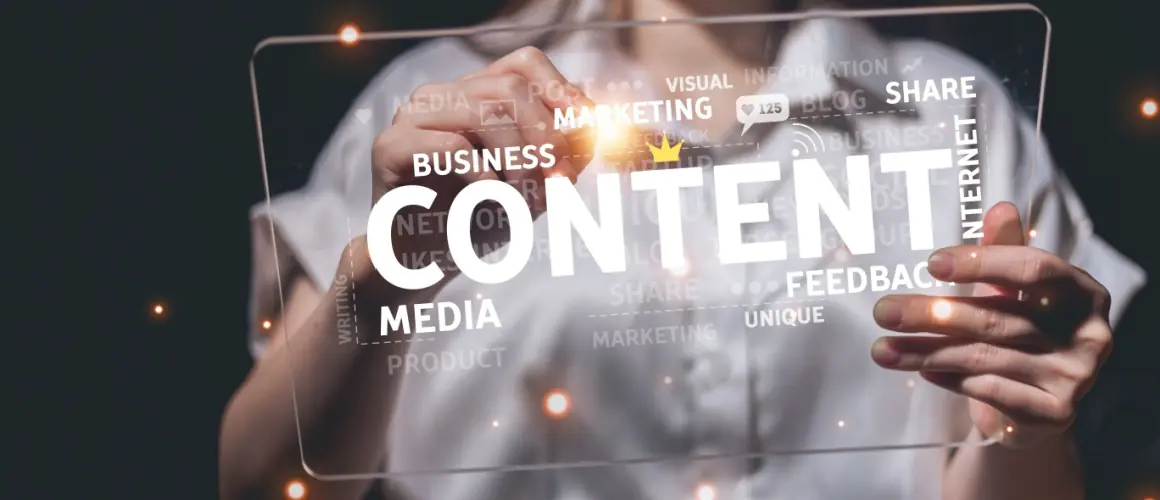
Collateral design is key to any good marketing strategy. It’s all about creating marketing materials that show off your brand. These materials, whether printed or digital, help build a positive brand image and keep brand consistency. From social media graphics to printed brochures, collateral design is important for talking to your target audience. As branding trends change, so do the ways and styles of marketing collateral design. This keeps your brand fresh and interesting.
In this article, we’ll look at why marketing collateral design is important. We’ll explore different types of marketing collateral and talk about the differences between online and offline materials. We’ll also give you a step-by-step guide on how to create marketing collateral that connects with your audience. Stay with us as we dive into the world of collateral design and share tips to boost your brand’s marketing.

What is Marketing Collateral Design?
Marketing collateral design involves creating various media items that support a marketing strategy and help promote a brand. These materials can be printed or digital and aim to build a positive brand image and ensure brand consistency. Examples include brochures, social media graphics, and other printed materials. The goal is to effectively communicate with the target audience and enhance the brand’s message.
Marketing collateral design is essential for any business. Especially since it helps in crafting marketing materials that highlight the brand’s identity. This includes everything from brochures and business cards to social media posts and videos. Effective marketing collateral ensures that all materials are visually appealing and consistent with the brand’s image. By doing so, it reinforces a positive brand image and makes a strong impression on the target audience.

Importance of Marketing Collateral Design
Marketing collateral design is vital for a company’s marketing strategy. It ensures that all marketing materials consistently showcase the company’s brand, helping to create a positive brand image and strengthen brand awareness. Here are some reasons why a company needs marketing collateral design.
1. Consistent Brand Image
Collateral design helps maintain a consistent brand image across all marketing materials. Whether it’s social media graphics or printed materials, a unified look reinforces brand identity, making the company easily recognizable to its target audience.
2. Effective Communication
Well-designed marketing collateral communicates the company’s products and services. It uses visuals and concise messaging to engage the audience and convey key information. This makes it easier for potential customers to understand what the company offers.
3. Support Sales Efforts
Marketing collateral, such as brochures and sales sheets, supports sales teams by providing them with high-quality, informative materials. You can then use these tools in various sales scenarios to explain products, answer questions, and persuade potential customers.
4. Enhance Marketing Strategy
Incorporating marketing collateral into a company’s strategy boosts its effectiveness. Different types of marketing collateral, such as ebooks, case studies, and infographics, cater to different stages of the buyer journey. This ensures that the company reaches and engages its audience at every step.
5. Build Brand Credibility
High-quality marketing collateral enhances the company’s credibility. Professionally designed materials reflect the company’s commitment to quality. In turn, this can instill confidence in potential customers and differentiate the company from competitors.
6. Increase Engagement
Engaging content, supported by compelling visuals, captures the audience’s attention. Collateral design that incorporates current graphic design trends can make marketing materials more appealing and effective in conveying the company’s message.
Marketing collateral design is essential for creating a cohesive and effective marketing strategy. It ensures brand consistency, supports sales efforts, and enhances communication with the target audience. By using various types of marketing collateral, companies can promote their brand and increase their reach and impact.

Points to Consider in Marketing Collateral Design
When designing marketing collateral, several key points need to be considered to ensure the materials are effective and align with your overall marketing strategy. Here are the essential factors:
1. Consistency with Brand Guidelines
Ensure that all marketing collateral design aligns with your brand guidelines. This includes using the correct logos, colors, typography, and messaging. Consistency helps in building brand awareness and trust.
2. Focus on the Target Audience
Design your collateral with your target audience in mind. Understand their needs, preferences, and pain points. Tailor the content and visuals to resonate with them and address their specific challenges.
3. Clear and Direct Messaging
Your brand message should be clear and straightforward. Avoid cluttered designs and ensure that your key points are easily understandable. This helps in effectively communicating your company’s products and services.
4. High-Quality Visuals
Use high-quality images and graphics to make your marketing collateral visually appealing. Design elements play a crucial role in capturing attention and making your materials memorable.
5. Engaging Content
Content marketing is essential in your collateral design. Create engaging and valuable content that provides useful information to your audience. This can include blog posts, case studies, and whitepapers.
6. Purpose and Goal Clarity
Be clear about the purpose of each piece of collateral. Whether it’s to educate, inform, or persuade, knowing the goal will guide your design and content decisions. This ensures that the collateral achieves its intended marketing efforts.
7. Brand Collateral Variety
Utilize a variety of brand collateral to reach different segments of your audience. This includes printed materials like brochures and digital formats like videos and infographics. Each type of collateral serves a unique purpose in your marketing strategy.
8. Maintain Brand Recognition
Ensure that your collateral enhances brand recognition. Use elements that are easily identifiable with your brand, such as specific colors and logos, to create a strong visual identity.
9. Tailored to Business Needs
Choose the type of marketing collateral that is best for your business. Depending on your industry and audience, some formats may be more effective than others. Check what works best to meet your business goals.

Types of Marketing Collateral that can Help you Grow your Brand
Effective marketing collateral design is essential for communicating your brand message and engaging your audience. Here are key points to consider to ensure your collateral meets your design needs and supports your marketing efforts.
1. Marketing Videos
Marketing videos are powerful tools for explaining a product or service. They enhance brand awareness and engage viewers through visual storytelling. Including videos in your collateral design can boost engagement and convey complex information succinctly.
2. Case Studies
Case studies provide real-world examples of how your product or service has benefited customers. They build credibility and show the effectiveness of your solutions, making them an essential part of your marketing content strategy.
3. Newsletters
Regular email newsletters keep your audience informed and engaged. They are ideal for sharing updates about your company’s products and services, promoting brand awareness, and maintaining a consistent brand message.
4. Blog Posts
Blogs are versatile pieces of marketing content that can educate, inform, and engage your audience. They help drive traffic to your website and support your content marketing strategy by providing valuable insights and information.
5. Podcasts
Podcasts are an excellent way to share in-depth discussions and insights about your industry. They appeal to auditory learners and can be an engaging addition to your digital content.
6. Whitepapers
Whitepapers offer detailed, authoritative reports on specific topics. They are valuable for providing in-depth knowledge and building trust with a more technically savvy audience.
7. Research/Statistics
Incorporating research and statistics into your collateral design enhances credibility. It provides factual backing to your claims. You can then present these in various forms such as infographics or reports.
8. Infographics
Infographics present complex information visually, making it easier to understand. They are highly shareable and can boost your brand collateral’s reach and impact.
9. Lead Magnets
Lead magnets, like downloadable guides or eBooks, attract potential customers by offering valuable information in exchange for contact details. They are essential for generating leads and expanding your audience.
10. Email Campaigns
Email campaigns are a direct way to reach your audience. Using well-designed email templates ensures your brand message is consistent and engaging, driving conversions and supporting your marketing efforts.
11. Sell Sheets
Sell sheets provide a quick overview of your products or services. They are useful in sales meetings and trade shows, offering concise and persuasive information to potential customers.
12. Landing Pages
Landing pages are designed for specific marketing campaigns. They guide visitors towards a particular action, such as signing up for a newsletter or downloading a resource, making them crucial for lead generation.
13. Banners
Banners are visual ads that capture attention. They should be visually appealing and aligned with your brand’s visual identity to drive engagement and conversions.
14. Logos
A well-designed logo is central to your brand collateral. It ensures brand recognition and consistency across all marketing materials, reinforcing your brand identity.
15. Ebooks
Ebooks provide in-depth information on topics relevant to your audience. They are valuable assets in a content marketing strategy, offering detailed insights and generating leads.
16. Branded Content
Branded content aligns with your marketing collateral by presenting your brand consistently and engagingly. It can be in the form of articles, videos, or social media posts that highlight your brand’s story and values.
17. Proposals
Proposals are formal documents that outline your solutions for potential clients. They should be clear, professional, and visually appealing to make a strong impression and support your sales efforts.
18. Re-engagement Emails
These emails target inactive customers to re-engage them with your brand. They are essential for maintaining customer relationships and encouraging repeat business.
19. Event Magazines
Event magazines provide detailed information about events and are great for engaging attendees. They can include schedules, speaker bios, and articles related to the event’s theme.
20. Reports
Reports offer comprehensive data and analysis on specific topics. They are valuable for presenting findings and recommendations and supporting decision-making processes within your organization.
Considering these points in your collateral design ensures that your marketing efforts are cohesive, engaging, and effective. By focusing on quality content and consistent branding, you can effectively communicate your brand message and achieve your marketing goals.
Online vs Offline Marketing Collateral Design
Collateral design is very important for both online and offline marketing. It helps businesses reach and engage their audiences. Knowing the differences between these two types of marketing collateral helps you choose the best method for your business.
Online Marketing Collateral
This includes digital content like websites, social media posts, email campaigns, and videos. It allows businesses to reach a global audience, target specific groups, and use real-time data to track performance. Online marketing is often cheaper because it has lower production and distribution costs. It also supports interactive marketing collateral, which engages users through clickable links, videos, and dynamic content.
Offline Marketing Collateral
This includes traditional media like brochures, flyers, business cards, and print ads. These materials have a physical presence that some people find more memorable. Offline collateral is great for targeting local markets and industries where face-to-face interactions are important. However, it usually costs more to produce and distribute. It also doesn’t offer real-time data, making it harder to measure success.
Advantages of Online Marketing Collateral
- Global Reach: Easily reach a broad audience.
- Lower Costs: More affordable than traditional advertising methods.
- Real-time Analytics: Immediate access to performance data.
- Precise Targeting: Tailor campaigns to specific demographics and interests.
Advantages of Offline Marketing Collateral
- Tangible Presence: Physical materials can be more impactful.
- Localized Reach: Effective for targeting specific geographic areas.
- Personal Interaction: Builds trust through face-to-face engagement.
- Less Digital Competition: Stands out in a less crowded space.
Both online and offline marketing collateral have their strengths and weaknesses. Online marketing is cost-effective, allows for precise targeting, and provides detailed performance data. Offline marketing offers a physical presence and works well for local engagement and personal connections. Using both strategies can create a balanced approach, making your marketing efforts more effective.

How to Create Marketing Collateral Design?
Creating effective marketing collateral design involves several key steps. Each step ensures that your marketing content is engaging and aligns with your business goals. Here’s a detailed guide.
Step 1: Define Objectives and Audience
Start by defining your objectives. Are you aiming to educate, generate leads, or promote a product or service? Knowing your goals will help shape your strategy. Next, understand your audience. Research their preferences, problems, and needs. This helps tailor your content types to resonate with them, ensuring that you solve their problems and meet their expectations.
Step 2: Choose Collateral Type and Content
Select the type of collateral that best suits your objectives and audience. This could include print collateral like brochures and flyers or digital content like videos and interactive content. Each type serves different purposes. For instance, use brochures for detailed information and videos for engaging storytelling. Ensure that your content includes a clear call to action to guide your audience on the next steps.
Step 3: Select a Designer and Draft
Choose a skilled designer who understands your brand and can meet your design needs. Work with them to draft your collateral. This draft should reflect your brand’s visual identity and message. Ensure the design is clear and visually appealing. A good designer will balance aesthetics with functionality to create effective marketing content.
Step 4: Branding and Data-Driven Refinements
Incorporate your brand elements consistently across all collateral. This includes logos, colors, fonts, and style. Use data and feedback to refine your drafts. Analyze what works and what doesn’t, and make adjustments accordingly. This step ensures your collateral remains aligned with your brand identity and communicates your message.
Step 5: Finish, Distribute and Measure
Once refined, complete your collateral design. Distribute it through appropriate channels, whether it’s online platforms or physical locations. After distribution, measure the effectiveness of your collateral. Use analytics tools to track engagement and conversions. This data helps you understand the impact of your marketing efforts and improve future campaigns.
Creating effective marketing collateral design involves careful planning and execution. By defining clear objectives, choosing the right content types, collaborating with skilled designers, ensuring consistent branding, and measuring outcomes, you can create collateral that effectively engages your audience and supports your marketing goals.

Partner with Synapse for High-Quality Collateral Design
Creating effective marketing collateral design is essential for a cohesive and impactful marketing strategy. By defining clear objectives, understanding your audience, selecting the right content types, and ensuring consistent branding, you can craft materials that resonate with your target audience. Utilizing both online and offline collateral maximizes your reach and engagement.
For expert assistance in developing your brand’s collateral design, consider partnering with Synapse, one of India’s premier branding and business communication design agencies. With over two decades of experience, Synapse has successfully worked with major organizations globally.
Explore our showcase and services on our website for more information. Contact us at 1800 121 5955 (India), email us at contact@synapse.co, fill in the Contact Form, or send us a WhatsApp message. A team member will get in touch with you promptly.







